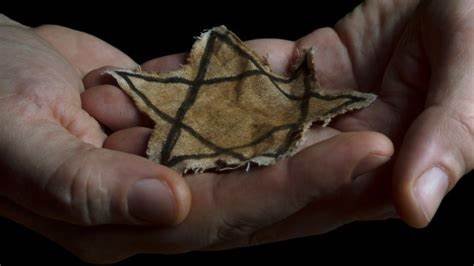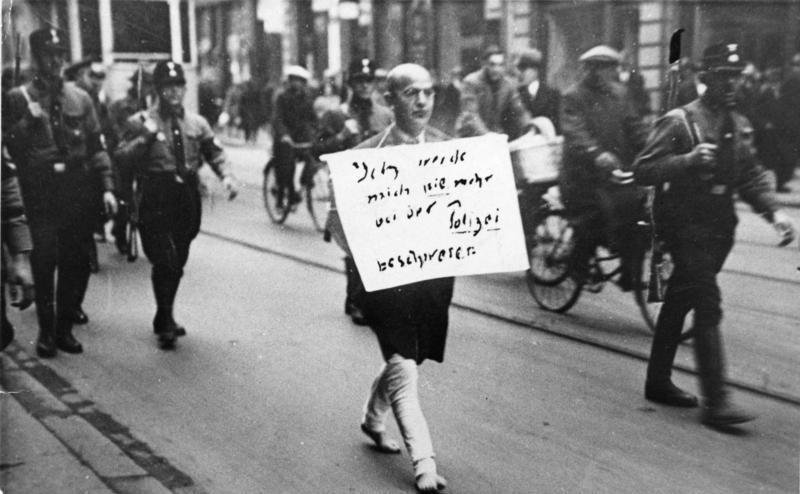
Organisation
The Holocaust in Germany was the systematic persecution, deportation, imprisonment, and murder of Jews in Germany as part of the Europe-wide Holocaust perpetrated by Nazi Germany. The term typically refers only to the areas that were part of Germany prior to the Nazi regime coming to power and excludes some or all of the territories annexed by Nazi Germany, such as Austria or the Protectorate of Bohemia and Moravia.
Overall, of the 522,000 Jews living in Germany in January 1933, approximately 304,000 emigrated during the first six years of Nazi rule and about 214,000 were left on the eve of World War II. Of these, 160,000-180,000 were killed as a part of the Holocaust. On 19 May 1943, only about 20,000 Jews remained and Germany was declared judenrein or "clean of Jews"
Anti-Jewish law
Throughout the 1930s, various German government agencies, Nazi Party organizations, and local authorities instituted a variety of anti-Jewish measures without centralized coordination. The first nationwide anti-Jewish laws were passed in 1933, when Jews were banned or restricted from several professions and the civil service. After hounding the German Jews out of public life by the end of 1934, the regime passed the Nuremberg Laws in 1935. The laws restricted full citizenship rights to those of "German or related blood", restricted Jews' economic activity, and criminalized new marriages and sexual relationships between Jews and non-Jewish Germans. Jews were defined as those with three or four Jewish grandparents.
In 1938 and 1939, another wave of legislation focused on forcing Jews out of economic life. They were barred from additional occupations such as real estate brokers or commercial agents, and forbidden to practice as doctors, pharmacists, dentists, or lawyers except for Jewish clients. The expropriation of Jewish businesses began in 1937 with their registration and enabled by a law passed in early 1938. In December 1938 a decree called for the shutdown of all Jewish businesses still in operation. Overall, the Nazis passed about 1,500 anti-Jewish laws.
The regime also sought to segregate Jews with a view to their ultimate disappearance from the country. Local anti-Jewish measures included signs declaring Jews unwelcome in a locality. Jews were banned from many spa towns and public amenities such as hospitals and recreational facilities. Jewish students were also gradually forced out of the school system. Some municipalities enacted restrictions governing where Jews were allowed to live or conduct business.
Emigration
The Nazi government wanted to force all Jews to leave Germany. Intensified persecution in 1938 caused the rate of emigration to skyrocket. The 1938 Évian Conference was organized to help Jewish refugees, but was not successful at easing immigration restrictions. By the end of 1939, most Jews who could emigrate had already done so; those who remained behind were disproportionately elderly, poor, or female and could not obtain a visa. The plurality, around 110,000, left for the United States, while smaller numbers emigrated to South America, Shanghai, and South Africa. Palestine was the only location to which any German resettlement plan produced results, via the Haavara Agreement that resulted in the emigration of about 53,000 German Jews, who were allowed to transfer RM 100 million of their assets to Palestine by buying German goods. Germany also collected nearly 1 billion RM from mainly Jewish emigrants from the Reich Flight Tax. In October 1938, Germany deported many Polish Jews. The policy of forced emigration continued into 1940.
Nazi SA militants in 1933 forcing a Jewish lawyer in Munich to walk with a sign that says "I will never again complain to the police"
Mass arrest of Jews in Baden-Baden after Kristallnacht
Who carried out the Holocaust?
Many groups of people were involved in carrying out the Holocaust. There were two Nazi groups in particular which organised the killing of Nazi "enemies", but Nazis also relied on informants to tell them what people were up to. The German army also played a role to in enforcing the Nazis' brutal rule.
The SS: The SS was a military-style group of Nazis, founded in 1925, who were like Hitler's personal bodyguards. They were in charge of overseeing the killing of people in the camps. Part of the SS called the Einsatzgruppen were put in charge of killing many people, before the extermination camps were opened to carry this out on a much greater scale. The SS also took control of intelligence, security and the police force.
The Gestapo: Established in 1933, the Gestapo were the secret state police. This group were in charge of rounding people up to send them to the camps.
Jews are deported from Würzburg to the Lublin District of Poland, 25 April 1942
Forced labor
Beginning in 1938—especially in Greater Germany—many Jews were drafted into forced-labor camps and segregated work details. These camps were often of a temporary nature and typically overseen by civilian authorities. During the last year of the war, people of partial Jewish descent and non-Jewish partners in mixed marriages were arrested and imprisoned in one of the many hundreds of camps
Dachau concentration camp main gate “works sets you free”
Deportation
At the beginning of September, all German Jews were required to wear a yellow star, and later that month, Hitler decided to deport them to the east. In conjunction with the mass deportation, emigration was banned. By the end of 1941, 42,000 Jews from Greater Germany and 5,000 Romani people from Austria had been deported to Łódź, Kovno, Riga, and Minsk, where most were not immediately executed. In late November, 5,000 German Jews were shot outside of Kovno and another 1,000 near Riga, but Himmler ordered an end to such massacres and some in the senior Nazi leadership voiced doubts about killing German Jews. Executions of German Jews in the Baltic States resumed in early 1942.
Around 55,000 German Jews were deported between March and June 1942, mainly to ghettos in the Lublin District of the General Governorate whose inhabitants had shortly before been killed in Belzec. Many able-bodied men were removed from the transports at Majdanek for forced labor. From mid-June some transports were directed to Sobibor where most deportees were immediately murdered. Others were deported to Minsk where instead of being imprisoned in the ghetto, almost all were immediately killed at Maly Trostinets. In late 1942 additional Jews from Greater Germany were deported to killing centers or ghettos in Eastern Europe.
Although the Nazis' goal of eliminating any Jewish population from Germany had largely been achieved in 1943, it was reversed in 1944 with the deportation of around 200,000 Jews from Greater Hungary due to increasing demand for labor
Who was killed or persecuted in the Holocaust?
We know that the victims included:
Jewish people
Roma and Sinti people ('Gypsies')
Slavic people, especially in the Soviet Union, Poland and Yugoslavia.
Disabled people
Gay people
Black people
Jehovah's Witnesses
Political opponents
The meetings
On the afternoon of 12 December 1941, Hitler ordered the leading members of the Nazi Party to a meeting in his private rooms at the Reich Chancellery. Because the meeting took place in private rooms rather than Hitler's office, no official record of it exists. However, entries in the diaries of Joseph Goebbels and Hans Frank confirm it. Goebbels made the following entry in his diary for 12 December:
“Regarding the Jewish question, the Führer has decided to make a clean sweep. He prophesied to the Jews that, if they yet again brought about a world war, they would experience their own annihilation. That was not just a phrase. The world war is here, the annihilation of the Jews must be the necessary consequence”.
Apart from the fact that the European war had turned into a world war, another reason for this shift was the fact that the entry of the United States into the war meant that the Jewish population had lost its value for Hitler as hostages deterring the United States from becoming an active member of the Allied coalition, and he was finally free to act according to his long-term plans.
Hitler's presence at the Chancellery meeting undermines allegations that he was unaware of the Holocaust and that it was carried out by subordinates without his knowledge.
The meeting marked a turning point in the Nazi regime's attitude towards the Jewish people. It was part of a shift from propaganda, intimidation, and attacks to outright and planned extermination. The latter step had already been taken in some parts of Eastern Europe as early as August 1941. The better-known Wannsee Conference in January 1942 marked the next step in the Nazis' plans to exterminate the Jews.
Meeting in Hitlers private rooms at the Reich Chancellery
House of the Wannsee conference 1942, clicking the picture will take you to my page on Wannsee.
High ranking Nazi party officials were obligated to attend this meeting. No official attendance list exists, but the following leaders of Nazi Germany, out of the about 50 present, are known to have been there:
Adolf Hitler
Heinrich Himmler
Joseph Goebbels
Martin Bormann
Hans Frank
Philipp Bouhler
In addition, Christian Gerlach writes that it is "virtually certain" that Alfred Rosenberg; Gauleiters Arthur Greiser, Fritz Bracht, and Fritz Sauckel; Reichskommissars Hinrich Lohse and Erich Koch; and Alfred Meyer were present.
The Wannsee Conference was a meeting of senior government officials of Nazi Germany and Schutzstaffel (SS) leaders, held in the Berlin suburb of Wannsee on 20 January 1942. The purpose of the conference, called by the director of the Reich Security Main Office SS-Obergruppenführer Reinhard Heydrich, was to ensure the co-operation of administrative leaders of various government departments in the implementation of the Final Solution to the Jewish Question, whereby most of the Jews of German-occupied Europe would be deported to occupied Poland and murdered. Conference participants included representatives from several government ministries, including state secretaries from the Foreign Office, the justice, interior, and state ministries, and representatives from the SS. In the course of the meeting, Heydrich outlined how European Jews would be rounded up and sent to extermination camps in the General Government (the occupied part of Poland), where they would be killed.
The Imperial War museums video is all about the Holocaust with a focus on organisation.





